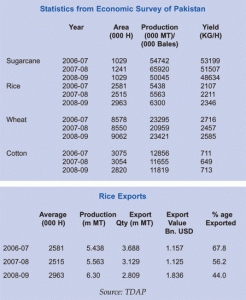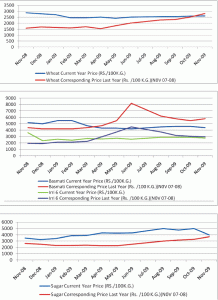Ensuring availability, accessibility and affordability of food to the population remains one of the foremost roles of the state (government). This process entails a detailed public policy framework comprising of agricultural policies underscoring sustainability as well as enhancements in productivity, factor and product pricing and ensuring food availability through functioning markets. In developing countries with structural bottlenecks and weak institutions, the state’s responsibility needs to be shared by commodity traders as well.
Pre-Washington consensus public policy on basic food commodities was hinged on a two-pronged strategy: First, guaranteeing a minimum price to farmers for their produce (calculated on the basis of factor input costs) through heavy buying of the produce by the public sector; and second, a government determined sale price for consumers to control food inflation and ensure affordability throughout the year with little price fluctuation. This was done though releasing quantities from government bought stocks to stabilize prices.
Significant government intervention in the basic food commodity market was justified at the time due to:
1.The cyclical nature of agriculture produce (that is, coming of whole crop once a year), which made growers liable to be exploited by the middlemen and merchants, who could lower prices through collusion as there was surplus produce in the market at the time and the growers wanted to clear their liabilities and get cash for the next crop.
2.Inelastic nature of demand for food commodities (wheat, rice and sugar) meant that little disruption in supply or availability of these items would result in large fluctuations in prices, which created an incentive for hoarding and controlling of the supplies for maximizing profits.
Mainstream economists favouring free market mechanisms saw government intervention in food markets as a distortion resulting in wrong price signals and inefficient allocation of resources. They were of the view that given a chance, markets are capable of efficiently regulating basic commodities and will result in better profits for the growers and economical food commodities for consumers.
The aftermath of the debt crisis which engulfed most developing countries in the early 80s, resulted in the rise of market orthodoxy in US and EC. IMF and WB free market-based stabilization and structural adjustment program-mes advised developing countries to withdraw state controls from basic commodity markets and allow establishment and management of markets in basic commodity trade.
Pakistan, like many developing countries also followed suit. During the last 28 years, the government, from having total control of food commodities (wheat and rice), has withdrawn from basic commodity markets; it now has a partial presence in the wheat market (government still procures 22-25 percent of national wheat produce) and has totally exited from the rice and sugar markets.
This process has been gradual, characterized by privatization of state-run sugar mills, closedown of state-run rice export corporation of Pakistan and privati-zation of its storage and polishing facilities etc. In recent years, the government’s role in the sugar and rice markets has been reduced to announcing the minimum purchase prices for both commodities and the start of crushing season for sugar mills but both of these announcements have only moral suasion and are partially followed, if at all.
After having taken itself out of actual buying of sugar and rice, it has been witnessed that the government has repeatedly faced difficulties in ensuring fair prices both at farm-gate to the grower and later to the consumer throughout the year. This has been despite very stringent basic food stuff regulatory state laws.
Wheat is the last commodity in which the state still retains a strong role as it not only sets minimum purchase price based on the cost of production but maintains it as well by purchasing 20-22 percent of the crop. This purchase, storage and subsequent release of wheat results in fairer returns to the grower and stable wheat flour prices to consumers year round.
Uptil 2004, pricing and availability trends in basic food commodities remained more or less stable apart for the years when crops failed. However, since 2004 food commodities pricing and availability have seen constant volatility.
Pakistan exported 500,000 metric tons (MT) of wheat in 2007-08 and in five months, the government had to import wheat worth 860 million USD to stabilize wheat flour prices although country had enough wheat for local consumption. There was a good wheat crop in 2008 – 2009 and a bumper crop in 2009 – 2010, but a huge increase in minimum purchase price from Rs 450/40kg to Rs.625/40kg (2007-2008) and Rs.950/40kg (2009-2010) auto-matically pitched the price of wheat flour beyond Rs. 30/kg (adding 24 percent as overhead and overhead charges).
Furthermore, provincial governments decided to subsidize wheat flour below purchase price (selling wheat at Rs. 250/50 kg to flour millers) during the month of Ramadan.
Rice consumption in Pakistan is estimated at about 2.5m MT.
During the last three years rice export proceeds have increased to USD 1.836 billion (see table 2) owing to the increase in international rice prices and discovery of African markets for low valued IRRI rice. Export of low value rice, which is stable food for poor in Pakistan and was available at Rs. 6-9/kg before discovery of African markets became out of reach for local consumers tou-ching peak at Rs. 45/kg last year.
During the current harvesting season (starting from October) there have been constant complaints by growers about the decrease in minimum purchase price fixed by the government from the last year, despite government’s commitment to purchase 1.00 m MT at the fixed price to stabilize prices in the market in the wake of bumper crop. There have been concerns about top rice exporters acting in tandem to purchase rice at lower than the government fixed price and to add to it rice prices have not shown any downward trend even after new crop has hit the markets.
First, recent sugar crisis in 2005 resulted from a drop in yield to 44.67 m MT resulting in sugar production of 3.00 m MT only and the government resorting to heavy imports costing over 624 and 260 million USD 2005-06 and 06-07 respectively. Since then the sugar sector has been beset with constant problems between growers, millers and the government. Fixing of price of cane and premium, starting of crushing season (which is fixed as November 15 but never adhered to) and non-payments of crop arrears to growers by millers even after one year are some of the problems.
Growers got better prices during the last three years and millers made huge profits by controlling supplies (CCP is investigating sugar mills for cartelization and monopolistic practices). Despite regular sugar imports by the government, it has failed to stabilize sugar prices during this time. NA standing committee on agriculture has blamed the government and the State Bank for the ongoing sugar prices, estimating excess profits of Rs. 70-80 bn. Accumu-lating to traders and sugar millers, according to a Daily Dawn Report dated December 15, 2009.
Pricing Trends
Observing and comparing price trends in wholesale progression of these commodities during November 7-8 and November 8-9, one cannot help but observe a lack of any trend in pricing despite cyclical production of commodities, which should translate in lower prices when the produce hits the market and gradual increases until peaking just before the next crop hits the market.
This erratic pricing behaviour of commodities owes less to production and availability (not withstanding occasional weather related failure of crops) and perhaps more towards government factor and commodity pricing policies as well as profit maximizing behaviour of the commodity traders.
Since the last several years, the state (democratic or otherwise) has found it difficult to guarantee a fair return for the growers’ produce and ensure availability at affordable prices for consumers . Consumers have been complaining of ever rising prices of wheat flour as well as rice and sugar. Growers of rice and wheat lament exploitation by the middlemen by forcing them to sell their produce below government fixed rates through cartelization.
Rice growers have accused 45 biggest exporters of rice for colluding to reduce farm-gate prices of rice. Sugarcane growers have shown their frustration as they do not get fair prices for cane, payments are withheld by sugar-mills, and sugar mills refuse to pay the premium envisaged by government laws. Also, there are perpetual delays in the start of sugar crushing season thus reducing cane production by substantial amounts.
All these symptoms indicate a sort of adverse incorporation of all major stakeholders, selfish goals being pursued at the cost of others and a total lack of adherence to any rules and regulations.
While the scenario clearly speaks of complacency, ineptitude and weak regulation on the part of government it also manifests weak assemblage of consumer and agriculturist interest groups in the country who have been far off the mark in protecting their interests.
The fact remains that profit incentives are the best impetus to safeguard individual as well as group interest and this has been clearly manifested in windfall gains to rice exporters and sugar mill operators. Although it is certain that this profiteering spree in the short run is specially aided by the peculiar nature of farm produce in the presence of weak regulatory state and underdeveloped merchant business; however, in the medium to long run, the economic agents (growers) who try to adjust to the situation are forced to convert to other crops (for example, vegetables). These crops are safer from exploitation in their perception. Not to mention the consumer who has to spend more on food essentials resulting in reduction in consumption of other goods. The net result: there is a net loss in welfare and efficiency.
In the realistic scenario where the government’s ability to reign in and the powerful quest for maximum profits is too much to desire in the foreseeable future. The government’s policy options should incorporate efforts to develop a trust based partnership with all stakeholders especially those involved in processing and trading of essential food
commodities.
The relationship must be hinged on mutual gains resulting in maximizing welfare with minimum sacrifices in gains manifested through CSR. Through an increased awareness of corporate social responsibility amongst the traders, their profit maximizing instincts can be conditioned through moral suasion and voluntary action. Rice, wheat flour and sugar mills associations can be used as contact points to inculcate a sense of responsibility.
All mature businesses must retain a broader view of the future and draw strategies as players planning a long stay in the arena thus regulating their profit motives.








thats great :)
Great, in-depth analysis (reality)!